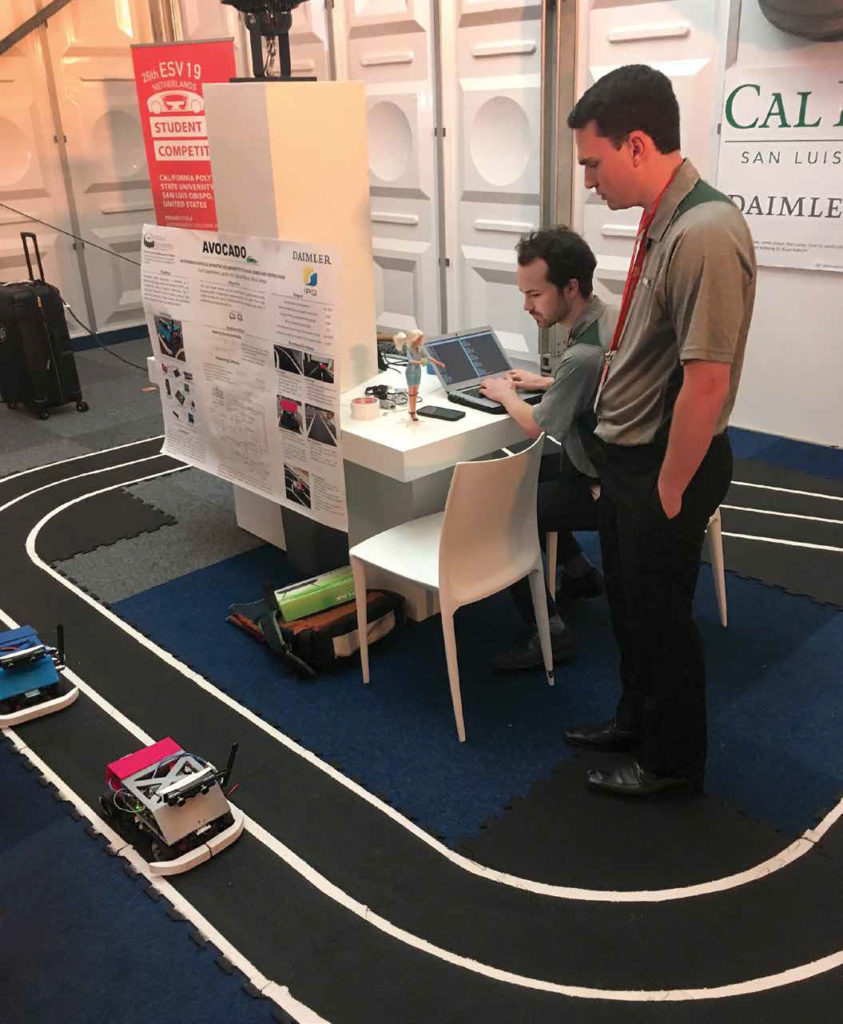the future of transportation
CAL POLY TEAM FINISHES SECOND IN AUTONOMOUS VEHICLE SAFETY COMPETITION IN THE NETHERLANDS
For nine months, things were going well for a team of Cal Poly students working on an autonomous vehicle project. But right after the students arrived in the Netherlands for the Enhanced Safety of Vehicles (ESV) competition, that abruptly changed.
“The lighting was different, which threw off our vision subsystems, our object detection algorithm quit working and we even blew a fuse and accidentally shut off power to our corner of the conference center for a little bit,” said Nick Lampe, one of four CPE students involved.
Yet, after two days of developing under intense pressure, things were running smoothly again — and the team finished second, just behind the Virginia Tech Transportation Institute.
“It was extremely rewarding to see industry experts so amazed with our work,” Lampe said. “They had such positive things to say, and it made the whole experience very worthwhile.”
Billions of dollars have been invested in autonomous vehicle technology, but so far the most it has produced for the general public is sophisticated cruise control and braking systems and some autonomous vehicles that operate under very constrained circumstances. Technology still needs to address safety issues, like poor weather and unforeseen obstacles in the road.
“Being able to identify pedestrians in the rain with oncoming traffic shining headlights into the camera is just one of many scenarios cars will need to be able to handle with near perfect precision before fully automated autonomous vehicles can be commercialized,” said Kiyoshi Moran, another CPE student on the team.
The Netherlands competition and conference, sponsored by the U.S. Department of Transportation, provided opportunities to share advances in autonomous vehicle safety. Cal Poly competed with five other universities from the U.S. and Asia, demonstrating their system and offering an oral presentation. Cal Poly’s team was the only one that didn’t
feature doctoral students.
The team specifically explored how two autonomous vehicles could work together, driving close to one another, and how autonomous vehicles could respond to an object in the road.
The platooning was accomplished with a combination of image processing and vehicle-to-vehicle communication. Meanwhile, a neural network was used to identify obstacles, and stereoscopic

cameras were used for distance estimation and path planning.
To help with this project, this year’s team included both CPE and mechanical engineering students for the first time.
“The mechanical students worked to create a mechanically stable and well-modeled platform,” said Bruce DeBruhl, a CPE assistant professor. “And the CPE students worked to develop algorithms to make decisions about what the car should do.”
Both DeBruhl and mechanical engineering professor Charles Birdsong acted as faculty advisors.
Autonomous vehicles could offer more than convenience. Close to 40,000 people are killed in the U.S. every year due to vehicle accidents, with driver error being a major cause. While automated vehicles offer the prospect of removing driver error, the problems encountered by the Cal Poly team illustrates the challenges in achieving that technology.
“Even with a full (school) year to develop and test for a very limited demonstration, trying to make our project work for all the edge cases and unforeseen circumstances was the most difficult,” Moran said. Lampe thinks the technology will eventually be there, but getting autonomous
vehicles on the road will require a buy-in from policy makers, the auto industry and the general public.
“So I don’t think that will be for many years still,” he said. “In the meantime, I think the smaller aspects of autonomous vehicles will continue to be integrated into cars on the road, such as adaptive cruise control, driver eye-tracking and obstacle alerting and lane keeping.”
